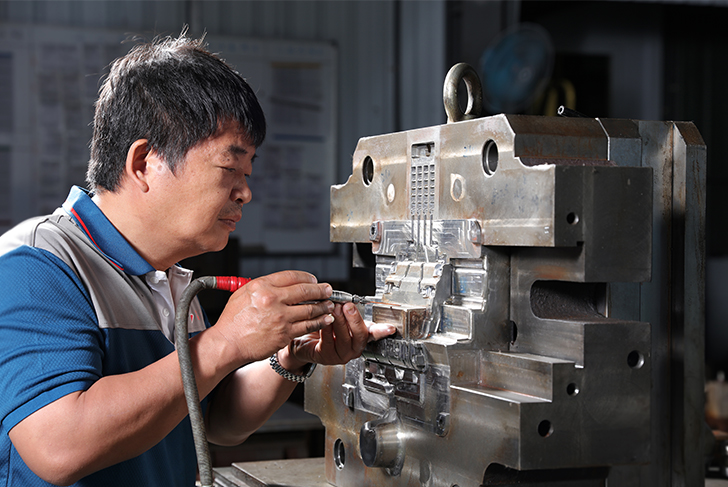- Home
- Die Casting
-
Engineering Feedback on Product Designs

-
Die-Casting Tooling Development and Maintenance

-
Die Casting

-
Deburring

-
CNC Machining

-
100% Inspection for Airtight Testing

-
Surface Treatment

-
Quality Inspection

-
Assembly Services

-
Packaging and Transportation

-
Dedicated Production Line Services

Die Casting
Precision Aluminum Die Casting and Zinc Casting Manufacturer
Chi Tai has the ability to make up to 40 die-casting machines available, with a locking force processing capacity ranging from 150 to 1200 tons.These are readily available for both small and large batch aluminum and zinc die-casting production plans. We also provide a wide range of high-pressure die casting applications, including using process monitoring, die-casting machine X-ray imaging, robot arms, Hitachi ADSTEFAN mold flow simulation software, and mold maintenance plans to extend mold life, shorten cycle time, reduce costs, and provide high-quality castings. From precision aluminum parts manufacturing and precision machining to final assembly production, Chi-Tai can provide you with integrated services for the entire manufacturing process under a management system from the beginning to the completed products.
Aluminum Die Casting Manufacturer and Precision Aluminum Parts Company
With over 40 years of experience, Chi-Tai has become a global leader in aluminum and zinc die casting, using its technical expertise and skilled professionals to manufacture high-quality alloy castings for customers in the most cost effective ways possible. We are committed to on time delivery, so you can rest assured that your goods will be completed on time.
Why Choose Chi-Tai As Your Aluminum Die Casting and Zinc Casting Manufacturer?
- Chi-Tai is a aluminum and zinc die casting manufacturer that provides services ranging from design concepts to production and packaging. We have fulfilled orders for products in various industries in different countries, such as the United States, Europe, and Japan.
- Chi-Tai can resolve problems. Our customers value our ability to turn complex design specifications into completed products.
- Chi-Tai can handle all of the aspects regarding aluminum and zinc die casting, from mold design and testing to precision aluminum and zinc part manufacturing, post-processing tasks, including grinding, machining and coating, and the packaging.
The advantages of Chi-Tai die casting manufacturing functions are:
1 Quality Stability with Excellent Equipment
Chi-Tai also uses multiple forms of technology to ensure efficient completion of any die-casting project.
- Using the Thurner minimum filling time (MFT) vacuum system leads to exhausting air inside mold cavities before injecting the alloy, and thus improving the integrity of the metal casting, as well as reducing mold wear. This process makes the part fill quickly by reducing back pressure and ensuring a high injection rate. Products produced by applying the MFT system have:
- Better surface smoothness
- Reduced gas porosity
- Reduced leakage problems
- Using a superior quality electronic furnace: temperature stability is the most important casting factor, ensuring the products’ quality stability during manufacturing.
- Using a central melting furnace and automatic liquid distribution, while limiting exposure to dangerous environmental factors during the production process.
2 Quality Management in Die Casting Plant
- On-site personnel conduct quality patrols every 2 hours during mass production to prevent unexpected situations and ensure that quality products are produced on time.
- Using a superior quality electronic furnace: temperature stability is the most important casting factor, ensuring the products’ quality stability during manufacturing.
- Using a central melting furnace and automatic liquid distribution, while limiting exposure to dangerous environmental factors during the production process.
3 Semi-Automated Circular Production
Automation improves production efficiency.
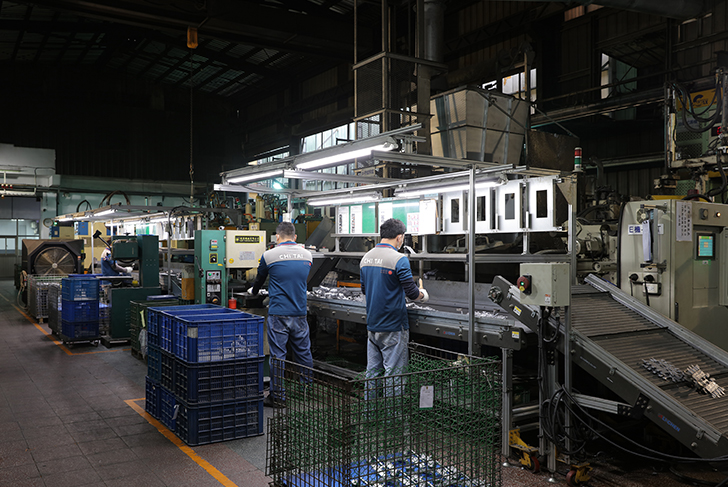
4 Die-Casting Equipment Overview (On-site Capacity and Partnered Facilities):
We manage a tightly coordinated supply chain and possess a total of 40 die-casting machines on-site, each equipped with the latest technology to meet a wide range of production needs. In cases of exceptionally high demand or specialized requirements, we have established partnerships with trusted local facilities, allowing us to seamlessly scale our production capacity.
Die-casting Factory Tour
Step 1: Aluminum Ingot
- We use A383 aluminum, which is also known as ADC12, which is the most widely used aluminum material worldwide, and is suitable for die-casting due to its excellent fluidity characteristics.
- Our components are made entirely of an aluminum compound material with carefully selected alloy contents. This ensures that there is no risk of accidentally mixing the aluminum compound with other materials during production, which contributes to maintaining its purity.
- Our supplier, Fa-Chia Metal Enterprises, has been our aluminum material supplier for years. Compared to less expensive aluminum material suppliers, Fa-Chia's aluminum material is known for providing stable, high-quality materials.
Step 2: Central Melting Furnace
- Using our high performance central melting furnace ensures setting a consistent temperature. It is specifically designed for melting aluminum ingots, providing greater efficiency compared to the use of multiple furnaces, which and resulting in significantly optimizing energy savings.
- The furnace can reach temperatures as high as 720°C for aluminum smelting.
Step 3: Automatic Carrier
In this phase of the production process, molten aluminum material flows for 24 hours on an automatic carrier device, instead of being handled by plant personnel, which precludes the risk of human error.
Step 4: Electronic Holding Furnace
Once the purified molten aluminum is produced, it is poured into a separate electric holding furnace. This helps keep the aluminum in a heated liquid form until it can be poured into die-casting machines and then solidified. This process ensures that the molten aluminum is always kept at a constant temperature of 660±10°C, which helps maintain the stability of the manufacturing process at all times.
Step 5: Die-casting machine
- Die casting machines perform the process of casting metal by pressing molten metal into a mold cavity under high pressure.
- Our factory has a range of die-casting machines, ranging from 150 to 420 tons, that can produce most types of castings.
- We work closely with our supply chain, and have 40 die-casting machines to ensure we have enough production capacity. Chi-Tai is able to produce castings with a locking force of up to 1200 tons.
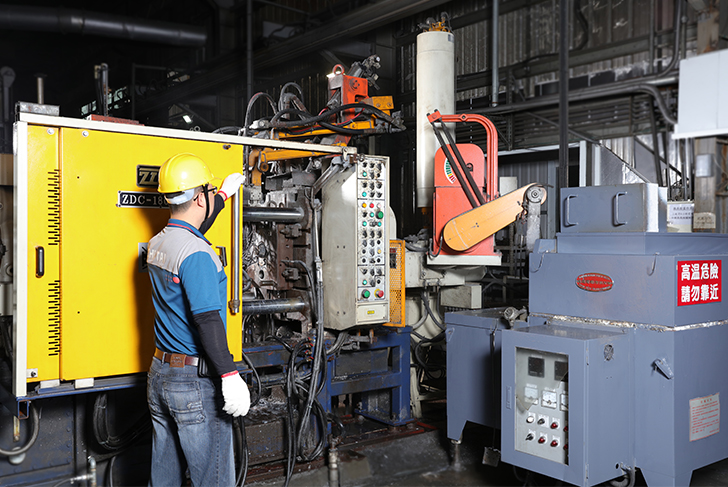
Precision Aluminum and Zinc Die Casting Capabilities
-
Chi-Tai has complete die-casting capabilities on site to meet customers' requirements for die-casting quality control. During the process of aluminum and zinc die-casting manufacturing, porosity (shrinkage or gas porosity) may naturally occur. Factors related to part dimensions, mold design, and manufacturing processes are important considerations for reducing porosity. Porosity can cause parts to fail to lock out various gasses or fluids under pressure, leading to product failures, and can also determine the viability(useful) of the part.
-
Pressure injection is a fast and effective process that can reduce the inherent porosity problems that are sometimes found in die-casting parts. Injection is an essential part of the process in the vacuum chamber. First, the molten aluminum is injected into the mold cavity to fill the voids caused by shrinkage or gas porosity. Next, the molten aluminum solidifies into a solid, filling the voids and sealing off these leak paths. If the castings are properly treated, they are appropriately completed without defects, and the appearance or dimensions will not change.
Vacuum machine
- To minimize porosity, each die-casting machine is equipped with a vacuum machine. This function extracts air from any cavities in a mold, allowing the die-casting machine to inject molten aluminum into a vacuum space.
- By doing so, we can prevent porosity from entering the molten aluminum and causing sand or air holes during the die-casting process. The ultimate goal of this process is to reduce porosity in the die-casting sample.
Step 6: Removing the Scraps
- The die-casting mold contains a customized biscuit and a runner with an overflow well, which enables the molding of components within the mold.
- Once the die-casting molding process is finished by using a die-casting machine, the product is conveyed by a conveyor belt to a centralized workbench, where the scraps can be eliminated either manually or by using a stamping machine.
What is the process for managing a die-casting plant?
1. Quality Control Management during the die casting process
At the die casting plant, we have a team of quality assurance personnel who diligently monitor the quality of die casting samples. There are two operators on duty during both day and night shifts, and their responsibility is to inspect the critical dimensions of die casting samples, ensuring that the mass-produced castings in the manufacturing process are stable and meet our clients' requirements.
2. Production Process Traceability Within 24 Hours
To detect any defective products during production, each casting sample will be placed on a shelf every 2 hours. This enables us to continuously trace production history.
During these regular spot checks, our quality assurance personnel can identify any defects and review all of the mass-produced products. Should any defects be found among these samples, our quality assurance inspector can immediately halt production and address the issue before production can be resumed.
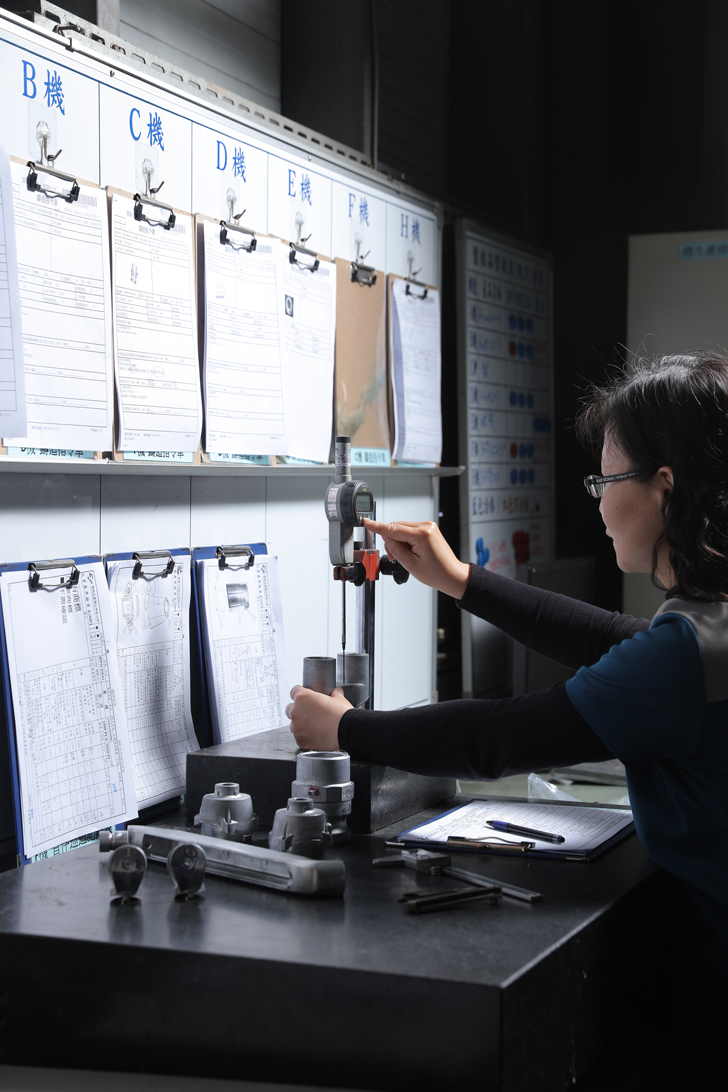
The following die-casting samples are stored on a shelf:
- Standard samples: these are the samples that clients approve after the small-scale trial production of the first batch. If any defects occur during this first production batch, plant personnel can compare it with the standard sample.
- The first sample: this is the first accepted sample produced from the batch that is made by using the master sample mold.
- Temporary samples: these are the samples collected every two hours during the production process to trace defective products.
- Final sample and sample storage: these are the final approved samples produced from the batch using the mold. They will serve as the standard for the approved sample for the next scheduled mass production, and will be stored in the sample storage space thereafter. Plant personnel use the final sample to ensure uniformity of sample conditions before it is used in the next scheduled production.
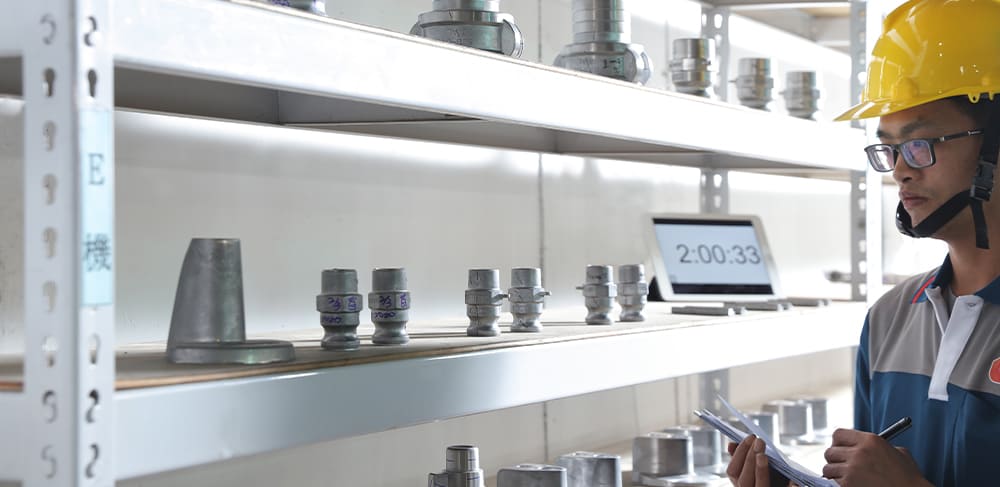
3. X-ray Inspection Machinery
Due to the manufacturing process of casting through high-pressure fluid injection, the occurrence of porosity is unavoidable. However, by utilizing X-ray machinery for inspection, we can detect and identify porosity issues that are not visible to the naked eye.
4. Chi-tai's On-Site Mold Factory
The on-site mold factory is responsible for performing maintenance work on molds, such as removing carbon within the factory to prevent dimensional defects during the next die-casting production.
